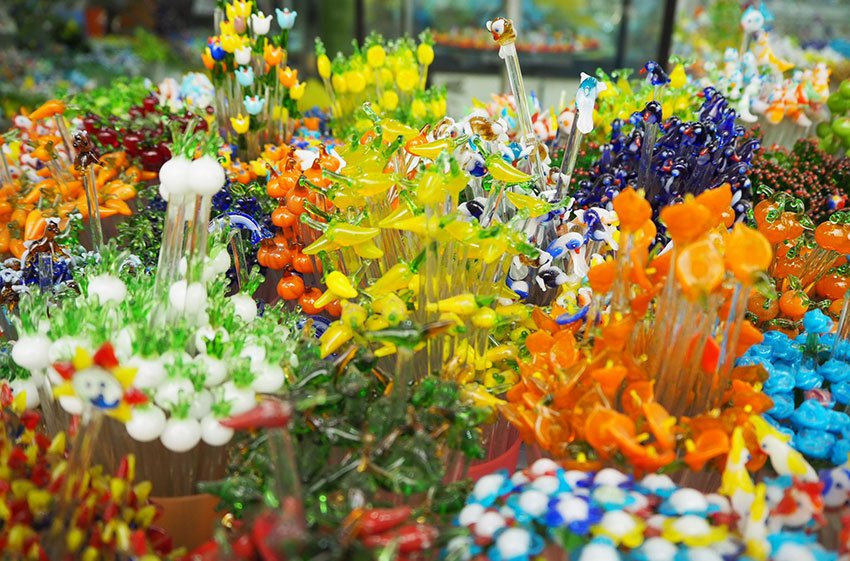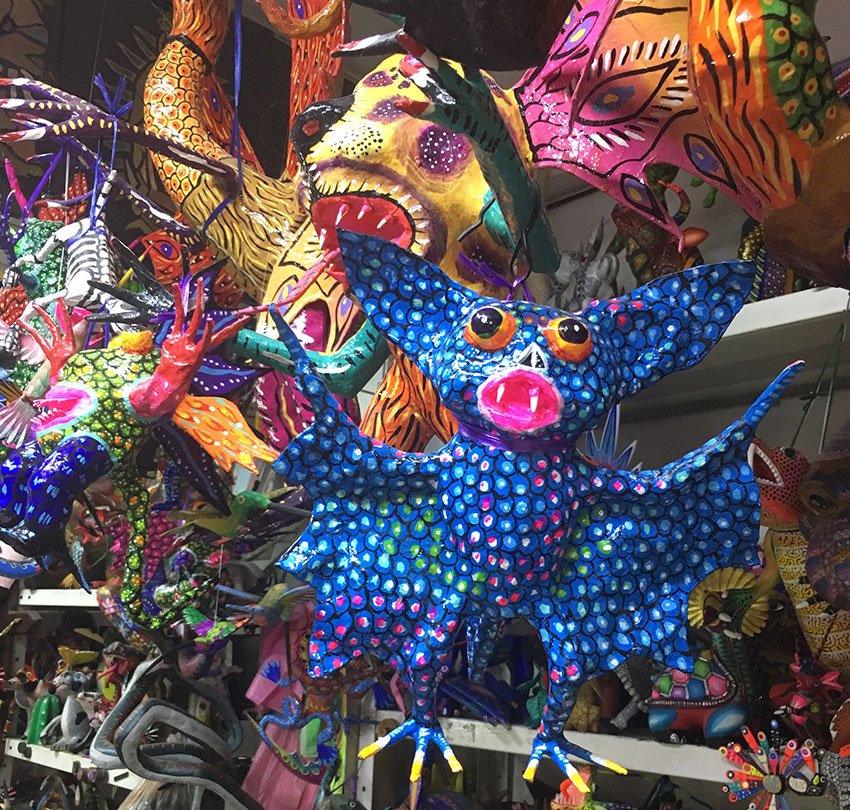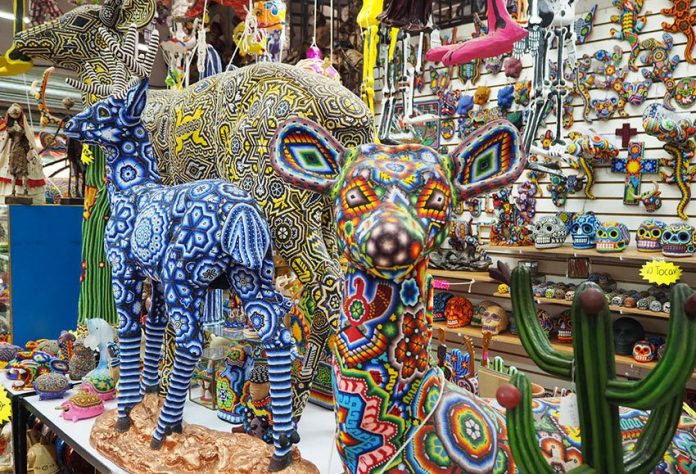In Colonia Centro, Mexico City, across the park from the original Ciudadela where Mexican independence leader José María Morelos was jailed before his execution, and where much of the blood of the “10 Tragic Days” of the revolution was shed a century later, sits a monument to a different kind of Mexican history – the collected handiworks of artisans from Sonora to Yucatán.
At first view when entering on Balderas and Emilio Donde, the Mercado de Artesanías La Ciudadela appears to be the cheeseball tourist entanglement sort of souvenir market, with cartoon Frida t-shirts, tequila magnets and bright green ponchos that scream, “Spring Break!”
But just a few paces in and the true handmade crafts come into focus, many of them created to order, on site.
At Familia García, the doña is busy with a gang of Japanese tourists gobbling up her tiny, exquisitely designed colored glass animals, flowers and cactuses set atop glass swizzle sticks. Her grandson works with a torch at a well-worn table in the corner to create more stock. At only 7.50 to 10 pesos a pop, they’re hard to resist.
The government originally established the Artisan Market as “La Feria de la Ciudadela” on June 1, 1965 in preparation for the 1968 Olympics as a way to display the traditional arts and crafts of the cultures of Mexico to visitors from around the world.

Then, during the 1970 World Cup, the market sold related souvenirs, as well as artisan goods, and it was such a success that it was soon established as a permanent market.
Textiles from Oaxaca, silver from Guerrero, ceramics from Chiapas and beaded art from Nayarit – a tour through the traditions and colors of Mexico under one roof. At Mercado de Artesanías, your wallet is your oyster — you can get a well-made blanket for only 130 pesos (US $7) or a life-sized Huichol bead-coated deer for 120,000 (US $6,280).
Walk into a mind stupor of hundreds of hanging alebrijes – the fantastically bright animal figures, kaleidoscopic in color and form. I was surprised to learn that the story of these famed Oaxacan flying donkeys and eagle-headed lions only goes back to the 1930s, when artist Pedro Linares dreamed them up in a deep fever and created the first alebrijes out of cardboard and papier-mâché.
At La Casa del Alebrije, a man sucking on a toothpick with an earring declaring his love of ska music capably though reluctantly helps through the designs. The papier-mâché varieties are made locally and can go for as little as 400 pesos, while wooden versions come from Oaxaca and can go as high as 6,000.
Inside Escorcia the walls and glass cases reflect a brilliant shine from silver mined from Taxco and obsidian from Teotihuacán.
At Imperart the hand-carved statues of eagles and Aztec and Christian gods shimmer blue, silver and copper from an electrolytic chemical coloring process.

At Tejidos Típicos, all of their wonderfully colorful textiles are made by hand on wooden looms, as they have been for centuries. They have everything from small table coverings and sarapes to huge rugs and embroidered dresses. Most of the larger pieces come from Tlaxcala, while many of the smaller ones are actually made on the loom inside the shop.
La Ciudadela provides the pleasure of actually seeing artists at work. You feel as if you’re walking through a tiny town, with restaurants and cafés at the palenque center. Abundant light and knowledgeable staff help to properly illuminate the goods.
Many of the larger ateliers are in the back of the market, surrounding the parking lot. In the stained glass studio of Vidrio Diseño Guzmán, Alan Guzmán is happy to show me around. Much of his work is done in the south of the city, but smaller pieces are created in the workshop upstairs.
Colored glass sheets sit on racks for the choosing, and clients can bring their personal drawings or choose from a library of popular designs for between 6,500 and 10,000 a square meter. The glass comes from Guadalajara and most of Guzmán’s handiwork goes into churches or centerpieces on residential entrance doors, he tells me.
Across the way at Decor-Art, Ernesto Bonilla has been pounding and sculpting tin into lamps and mirror frames for nearly 40 years. His work is classically Mexican and some of the most perfectly produced that I’ve seen at the price, many featuring Talavera tiles from Hidalgo – from around 550 pesos for wall mirrors to about 800 for full-size standing ones.
Like a practitioner of the modern nose-to-tail movement, Bonilla says he uses every part of the tin. “I get it in sheets because I’m not a huge producer,” he tells me. “So I use every little scrap – for the hanger or the pieces on the back to hold the mirror into the frame.”
Just like every great artisan, Bonilla learned his craft on the job. “From watching friends,” he says. “We’d get together, have a little drink, hang out. And I saw them working. I asked if they’d loan me some tools. And I started from there.”
Maybe bring a beer or two with you to the artisan market, you could learn something. And there are always group dance classes at Plaza de La Ciudadela across the street, for when the beer kicks in.
• Mercado de Artesanías is located at the intersection of Balderas and Emilio Donde, Colonia Centro, Mexico City, and is open Monday through Friday, 10:00am to 6:00pm.
This is the ninth in a series on the bazaars, flea markets and markets of Mexico City:
- Sharpen your bargaining skills at the best little antiques market
- Mexico City’s most colorful market is Mercado Jamaica, the flower market
- You’ll find art at Mercado Coyoacán, but the main attraction is food
- MercadoRoma, a Mexican public market reimagined for the 21st century
- Tuesdays in Taxqueña, the flea market of musical brotherhood
- Escandón Market is quintessential middle-class CDMX neighborhood market
- A walk through the Mexico City markets of Colonia La Condesa
- The San Juan market, Mexico City’s epicenter for culinary inquisition
